The Rubber Plant (Ficus elastica) could be the ideal houseplant for you if you want a tough but easy going indoor plant that can reach staggering heights within just a few years.
The shiny glossy leaves look great in most homes and although young plants start off small they will fill the space in an empty corner quickly.
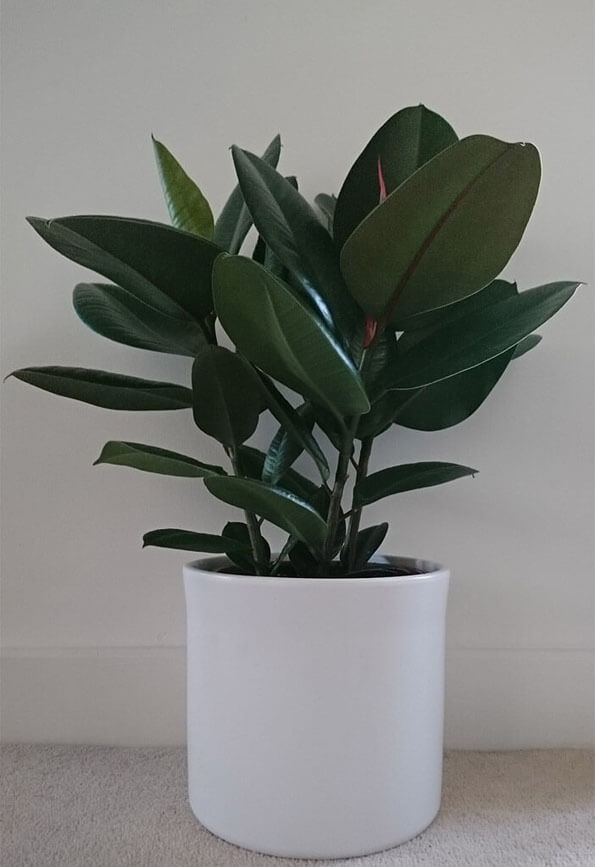
Even if you don't want to grow a really tall tree like plant indoors, the Rubber Plant's size can be restricted to an extent with regular pruning. However you have to keep in mind these houseplants are determined to grow upwards, no matter what and don't stay small and compact forever, eventually requiring a certain amount vertical of space.
Rubber Plants are determined to grow upwards, no matter what
Around 30 years Rubber Plants were incredibly popular, but people started to live in more modern homes and apartments which tend to be smaller. Space became a premium and one of the first things to go was the giant Rubber Plant in the corner!
They fell out of fashion and became hard to find. Fortunately within the last 5 years they've bounced back and are once again fashionable and prominent statement houseplants and for good reason. They're easy to care for and very forgiving house guests.
Dr Wolverton ranks the Rubber Plant as one of the very best houseplants to clean the air. It also scores really well with resistance to pests and diseases and has a high transpiration rate which increases the humidity of the room it lives in. In other words it's good for your health as well as low maintenance.
Did you know?
The Weeping Fig and the Fiddle-Leaf Fig are two other plants from the Ficus family that are also popular as houseplants.
The true Latin name for this plant is Ficus elastica, however the traditional early versions have generally been replaced by more modern cultivars and closely related varieties. For this reason you might find the plant labeled as Ficus robusta (which as the name suggests is much more robust and hardy), some sellers even do both and will slap Ficus Elastica Robusta on the name tag.
More specific named highlights include the compact Ficus Decora, and the dark green almost black leaved Black Prince and Ficus Burgundy.
You might also come across some of the variegated Rubber Plant types. These are harder to come by because they're trickier to keep looking great in homes as you can't skimp on the care requirement of bright light.
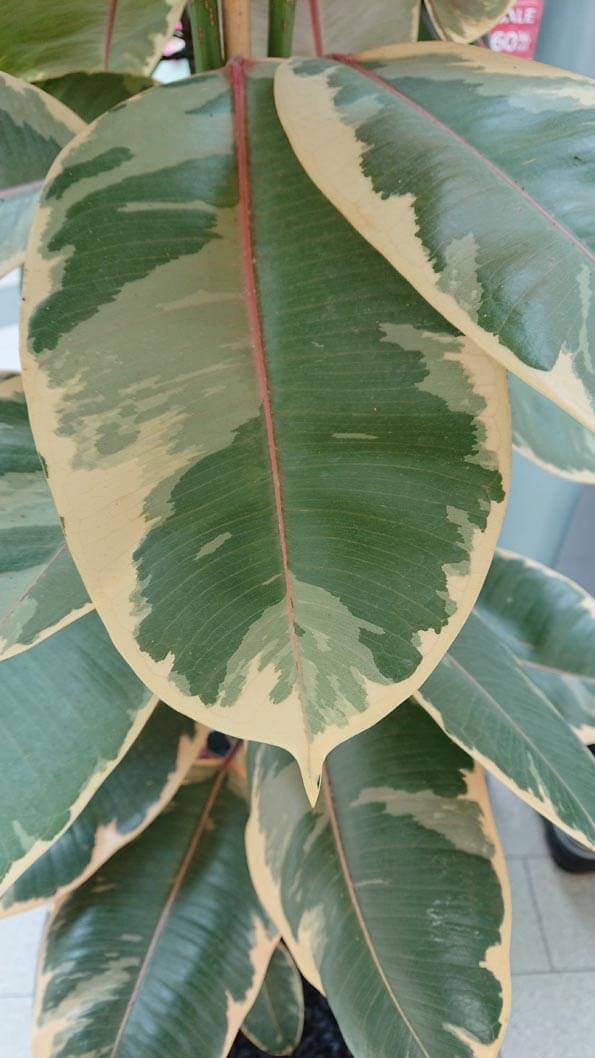
However, if you do happen to have a suitable place with good light levels for the variegated types, look out for Ficus Ruby which has pink and purple flushes in the leaves.
Doescheri sticks with splashes of different shades of simple greens and yellows but still looks beautiful in the right spot. Ficus Tineke is pretty much the same but more compact. The most common variegated type is pictured further above, resembling army khaki.
You may find this plant labeled either as a Rubber Tree or Rubber Fig. The "rubber" aspect of its name comes from the "rubber" white sap that oozes out of the glossy leaves and woody stems if they're scratched or cut.
There is often so much sap, that there can be a drip factor which you need to be careful with. Also the milky latex is not particularly pleasant to humans or pets if the sap is swallowed. It's also an irritant to the eyes and skin so handle the plant carefully and if you do happen to get any on you, make sure you wash it off afterwards and you shouldn't have any issues.
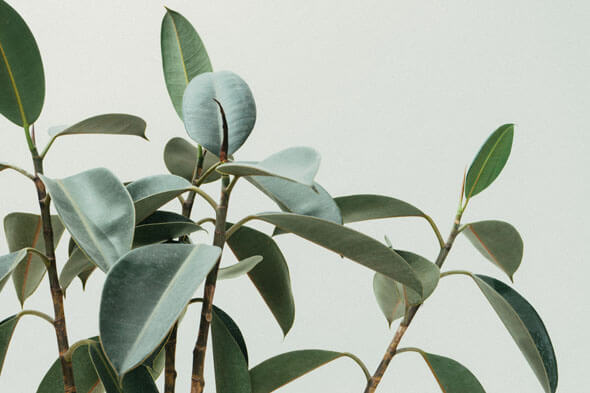

Hi, I'm Tom!
If you're like me and enjoy the challenge of growing houseplants and getting them to thrive, then Ourhouseplants can help. This website shares my knowledge and years of growing plants and provides (hopefully) helpful advice on properly caring for your indoor plant friends.
Grow away from continuous direct sunlight. Instead give your Rubber Plant a well lit spot with some indirect sun if possible.
The all green types will take some shade and poorly lit spaces, but too much for too long and the plant will become lanky and spindly.
If you have a variegated type you must provide bright indirect light, otherwise If you opt for shade, you'll lose the markings.
The Rubber Plant watering needs are simple - they love a good soaking when they're growing, but dislike constantly damp roots. We've found the best way to treat them is to water your plant really well once the soil surface and top inch has dried out, then wait until it dries out in the same way before watering again.
If you're watering more than once a week the Ourhouseplants.com Team are looking your way with narrowed eyes, questioning your technique. This might work for you and if it does keep doing it, but in most homes watering more than once a week is likely too frequent.
You shouldn't let a Rubber Plant sit in water, so after 30 minutes if there's still water remaining in the drip tray, pour it away. In Winter scale back and avoid the soaking, instead aim to keep the soil just moist, but remember to still let the soil dry out before coming back with the watering can.
You can mist the leaves from time to time when the air is very dry, but really you don't need to worry about humidity levels.
To produce those massive leaves the Rubber Plant needs feeding. Little and often is best, a weak balanced feed every couple of watering's during Spring and Summer.
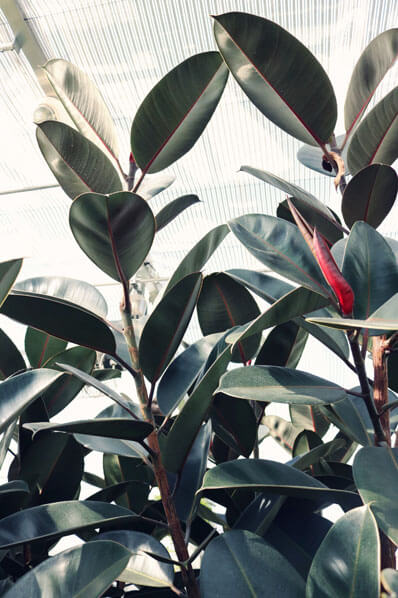
As with usual feeding rules, don't fertilise in Winter, or recently repotted and new plants for a good 3 to 6 months.
If your plant's not producing new leaves don't feed at all.
The Rubber Plant will be quite happy to grow in a broad range of temperatures between 10°C (50°F) to 29°C (85°F).
If you go hotter, the leaves will lose some of their turgid appearance. You can go as low as 4°C (39°F) in Winter if you have to, but your watering must be spot on. If you've overwatered at this temperature you'll quickly finish the plant off.
These plants grow quite big even if their pots are tiny.
These plants grow quite big even if their pots are tiny. However there will still come a point where the growth will slow down or even stop. You then have two choices, either leave it where it is and top dress instead.
Topdressing means scraping off the top inch or so of old soil and replacing with fresh compost which introduces fresh nutrients and beneficial microbes back into the old tired potting soil.
The second choice is to repot. Repotting a Rubber Plant is quite easy if it's not to heavy. All you need to do is move it into a bigger pot using a standard potting mix. If you're new to houseplants we have a more extensive repotting guide just for you.
We've never needed to propagated this plant! Firstly because one Rubber Plant in a home is almost always enough and secondly, they're really cheap to go out and buy. However propagating a Rubber Plant is easy if you follow the four steps below:
To get started you'll need a piece of stem, (often a growing tip), it needs to be about 4-6 inches (10-15 cm) long.
Remove all of the leaves bar one. If the sap is oozing wait until it stops (usually within 30 minutes) and then wash it off gently.
Plant the stem with the remaining leaf in either gritty compost or perlite. You can dip the cut bottom end into a rooting hormone, but it's not essential.
The growing media then needs to be kept barely moist, in a warm spot with indirect sunlight. Best results are obtained using bottom heat or doing it during Summer
Growth of your Rubber Plant can probably be described as moderately fast. Many owners put their plants outdoors in the Summer which they feel encourages a rapid surge of new leaves. Don't over do the sun exposure though and watch out for wet cool Summers which can encourage disease and possible overwatering.
Plants which are incredibly pot bound won't grow and don't expect any growth in the middle of winter as Spring and Summer are the growing months.
The end height and spread depends on how well your plant is treated. Rubber Plants in good conditions, big pots and with no regular pruning can achieve upwards of 9ft / 3M. Poor conditions, small pots or pruning will result in a shorter plant.
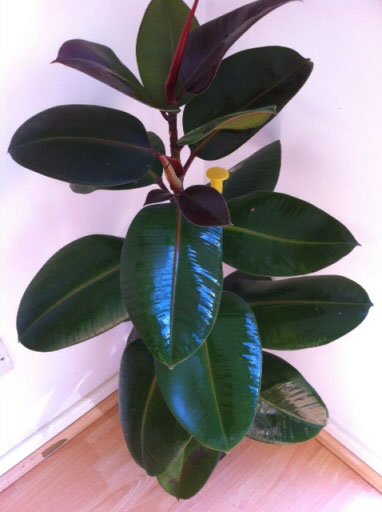
The width of the plant can be controlled through your choice of whether to prune or not. If you don't prune, the central growing stem will race for the ceiling unheeded giving a more narrow slender tree looking effect. If you'd rather your plant was more bushy and wider instead, read the next paragraph.
If you constantly cut / prune off the leading, tallest growth tips, then new growing shoots will form at the sides of the central stem lower down which will then create a branched, bushy looking style. This will end up creating a much wider houseplant, although even then it won't spread much wider than around 3ft / 1M in most homes.
Did you know?
Ficus is part of the Fig family which as a general rule do not have bright, striking or fragrant flowers.
You'll notice that new leaves will emerge from a colorful sheath which is often red and eye catching. This can often confuse new owners into thinking their plant is flowering.
You might get small fig like fruits on mature plants although there is nothing really striking about the flowers that form prior to this. The Rubber Plant is brought into our homes for the foliage rather than any potential flowers.
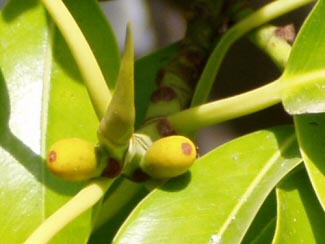
Yes the Rubber Plant is (mildly) poisonous to pets and humans. Many Ficus plants including F. elastica have a milky irritating sap in the stems and leaves that can cause gastrointestinal issues if eaten and skin irritation if the sap is allowed to rest on the skin for a time or gets into small cuts.
Dust is the biggest problem for indoor Rubber Plants. You will need to rub them over every couple of months with a damp cloth to keep them looking great. Leaf shine products can also be used for a glossy finish.
Good Light Avoid direct sunlight and very shady areas.
Moderate Watering Once a week in Summer and once every two weeks in Winter.
Temperature Normal indoor room temperatures. 10°C (50°F) to 29°C (85°F)
Feeding Try to fertilise once a month when it's growing.
Yellowing Leaves
This is normal for very old leaves. Otherwise it could be a sign of over watering or not enough light.
Rubber Plant leaves curling or drooping
This can happen when temperatures exceed 29°C (85°F), or when you've over watered. When the temperature cools or the soil dries out after a few days or so the curling and drooping look should disappear.
Extreme cold, such as exposure to frost, can also cause this to happen, however if this is the cause then the leaves won't return to normal after a few days and will instead quickly start to fall off the plant.
White streaks, drips on the leaves
A little knock or a little cut on a leaf or a stem can result in a large amount of dripping sap. This can fall onto the leaves below and dry out giving the impression something strange is happening.
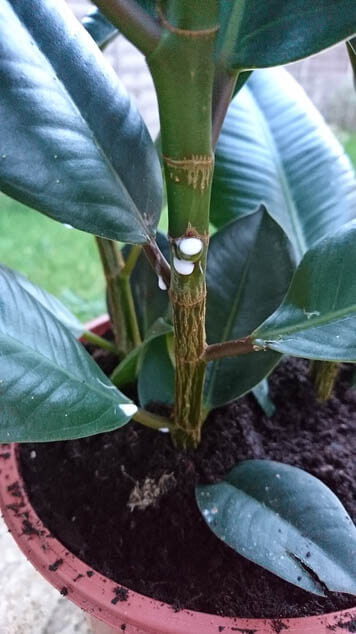
The sap, whether it's still wet or has dried out can just be wiped away from the leaves with a damp cloth.
Always take care when repotting or moving your Rubber Plant. The sap, as well as being mildly toxic and irritating, can be damaging because it can stain carpets or furniture.
My Rubber Tree Plant is too tall
Yes Rubber Plants do get big don't they! Fortunately they can be pruned without adverse effect (although you may need a step ladder to get into the canopy first!). Find the central stem and then cut where you're happy for the new top to be.
You might have to wrap the exposed stem for a few hours to stop the latex sap from dripping all over the place.
Afterwards two things should happen, firstly a new growth point takes over and it continues its rise upwards, or if your plant is really healthy you will get two (or more) new growth points. This results in a more bushy and branched plant. Use this pruning knowledge to design your perfect Rubber Plant!
White raised dots on my Rubber Plant
They might look like pests, or a disease, but these dots are actually perfectly normal and no treatment or special care is needed.
Pests
Pests are rare because the Rubber Plant is so resistant to them. However you can still expect Spider Mites and Scale insects to drop in from time to time.
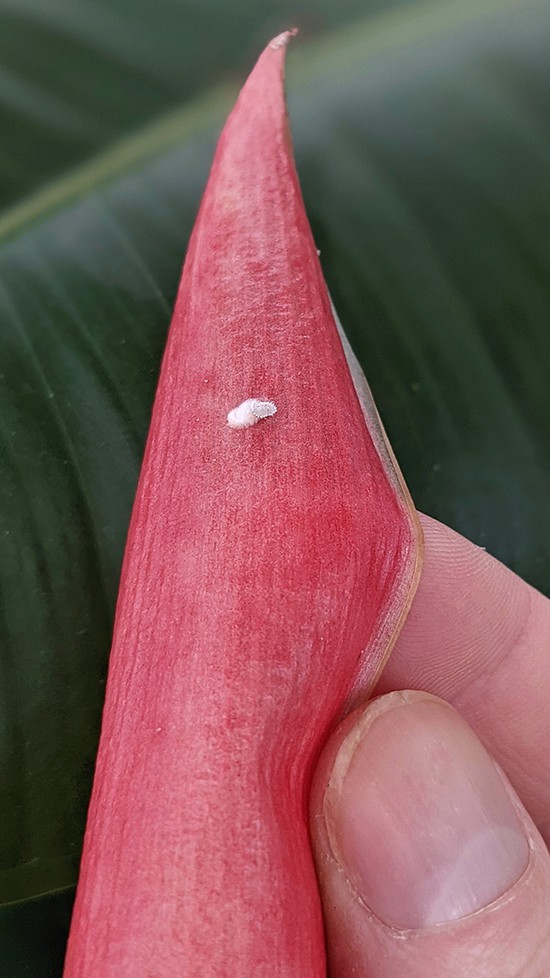
Mealy Bugs usually prefer new top growth to feed off. But they can spread to the lower leaves in time. If left untreated you'll get leaf drop.
Mealybugs can also set up a home on the leaves. They seem to do less damage in the short term, but make a huge mess and look terrible as they're so much bigger than your other typical bugs.
How to make a Rubber Plant bushy?
Over time, leaves will fall off if the light levels aren't quite right, or they've been damaged. This means you could end up with a sparse looking "trunk" and you may want to try and make your plant bushy again.
This question is one that comes up quite often, so we've covered it off above in our height / spread section.
Credit for the variegated Rubber Plant Photo - Gallery - Forest & Kim Starr
Credit for the photo of the top of a Rubber Plant - Article / Gallery - Scott Webb
Credit for the large Rubber Plant trees with red leaf sheath - Article / Gallery - Madison Inouye
Credit for the Rubber Tree fruit photo - Article / Gallery - Júlio Reis